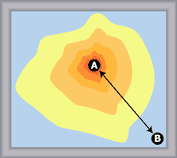Things to consider before tinting
Adding a solar control film to any glass will absorb additional heat into the glass. However, this depends on a number of factors.
1. The type of glass
Solar control film is not suitable for certain types of glass. If the glass is wired or double paned glass, you will need a professional assessment to see if the glass is susceptible to thermal stress breakage. This is what happens when the glass temperature varies from the edge to the centre of the glass so much, that it causes the glass to crack. Different glass types have different breaking points, so seek professional advice if you are unsure of the type of glass in your home. If the glass is laminated or tempered (toughened) glass, it is generally marked with a stamp or a sticker on the edge of the glass. Tempered glass has almost 0% chance of suffering a thermal stress break.
|
Basic guide for thermal stress breakage points of a pane of glass:
Temperature difference between point A and point B (hottest to coldest) will determine breakage point of glass. 2. The colour of the filmA black film will absorb more heat into the glass than a white or silver film of the same opacity. 3. The darkness of the filmAll film manufacturers make Visible Light Transmission (VLT) information easy to obtain. It is generally associated with the code or name of the film. For example film type HD15, stands for NatureVue High Definition 15% VLT, which means it allows 15% of visible light to enter through the glass. A darker film will generally result in more heat being absorbed into the glass. The more reflective the film is from the outside, the less heat that is absorbed into the glass. 4. The angle of the glass
If the surface of the glass is angled directly at the sun during the hottest part of the day or is a ceiling window, the glass may be more susceptible to thermal stress. Generally an externally reflective film should be used on almost all ceiling glass, with the exception of tempered glass. If the glass is laminated and has an existing tint in the glass, a film should be installed on the outer surface of the glass (an external film). Once again, a professional would be required to make the appropriate recommendation. You can locate a professional installer here. |





 Looking for an installer?
Looking for an installer? Tint Simulator
Tint Simulator


